
Tourism, water and energy: three key elements for sustainability
March 22 marks World Water Day, established by the United Nations in 1992. This year's theme is the link between water and climate change, an issue that deeply engages Fondazione Bruno Kessler's agenda. Let's see how.
FBK’s Digital Society center is participating as coordinator in NEVERMORE, a four-year research project, funded under the Horizon Europe program. The Sustainable Energy center, for its part, provides a support function for the Trentino case study, while the Tourism and Sports Service of the Autonomous Province of Trento plays in the lead role for the same case study.
The objectives of NEVERMORE – in which sixteen partners from eight countries are involved – are: to develop integrated models and tools for the simulation and assessment of climate change impacts and risks; and to implement new digital and interactive tools to help citizens, along with policymakers, to learn more about plausible future scenarios and act accordingly.
Among the five cases chosen for the on-the-field study of the project is that of Trentino, which is particularly affected by climate change in its mountainous areas, due to the increase in average temperatures and seasonal snow depths, the decreasing duration of snow cover, the melting and retreat of glaciers, floods, and increasingly long periods of drought. Consider how much all these phenomena impact winter tourism, in light of the need to produce artificial snow and the considerable demand for water and energy that such demand entails. Tourism, water and energy are thus strongly interconnected, and this is why we need to think about sustainable solutions, with a view to the common good.
But mountains, as we know, do not live by winter alone. In fact, research conducted at FBK over the past year has also been directed at the study of water scarcity in the mountains and its impact on the lives of mountain lodges (about 15 were taken into account), watched as true sentinels of climate change. To function and to provide hospitality to visitors in the warm season, mountain lodges need water. This is an issue that is not always easy to solve, and to which mountain lodges have responded in a variety of ways: structural investments (e.g., with the creation of new tanks for storing rainwater or water from melting ice and snow, dry toilets), practices for conserving available water, and strategies for producing it (restrictions on uses considered non-essential, such as showering; raising awareness among mountain lodge visitors, be they guests or hikers). The research work revealed how crucial it is to communicate the issue of water scarcity, and how technology can help in the work of raising awareness, for example through data physicalization. This is a solution that aims to bridge the gap between digital information and physical objects by providing new ways of interacting with data, capable of going beyond traditional visualizations or digital interfaces. More physical, tangible information could and should help to better understand the centrality of the issue.
How to best convey this information is a “work in progress” endeavor at this time, despite the fact that some scientific results are already available to the public. The solution to materialize data on water availability and consumption will take into account interviews conducted by researchers, as well as, of course, data analysis. This participatory approach, which has been present and relevant since the early stages of the work, will be maintained in the coming months, with the main objective of refining the understanding of the problem with the help of local players, as well as imagining together solutions and interventions that can ensure a more sustainable water usage.


